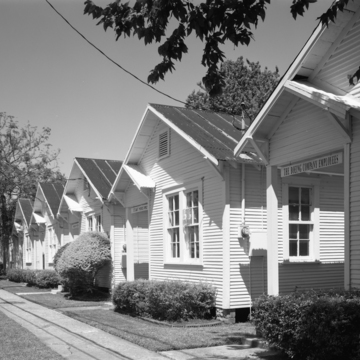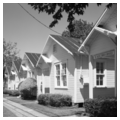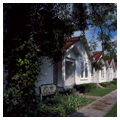Project Row Houses is a highly original work of site-specific public art. The originator, Rick Lowe, is an African American Houston artist. In the early 1990s Lowe was challenged by the question of how his art contributed to improving communities. This led him to think about the relationship of art production to low-income communities, especially communities of people of color. Inspired by a series of paintings that African American Houston artist John T. Biggers produced in the 1980s based on the theme of the shotgun cottage—a house type especially associated with African American communities—Lowe discovered two blocks with twenty-two derelict wooden cottages built c. 1939 as rental housing. The close-packed cottages were built four to a lot. They construct a linear rear court punctuated with back porches and clotheslines.
Lowe and cofounders Deborah Grotfeldt and Michael Peranteau recruited corporate volunteers to rehabilitate the houses under the direction of architect Sheryl Tucker de Vásquez. Ten of the houses are used for temporary, six-month art installations by an international and local array of artists. Another ten are used as housing for young mothers participating in a skills acquisition program. Additional houses accommodate literary and musical events and afterschool programs for neighborhood children.
In 1998, work was completed on a new, two-story house of moderate size at 2417 Division Avenue designed and built by Rice University architecture students under the direction of Danny Samuels and Nonya Grenader. In 2000, Project Row Houses acquired the modernistic former Eldorado Ballroom of 1939 by Lenard Gabert at 3206 Dowling Street, two blocks away, for use as a music performance center to celebrate the musical traditions of Houston's Third and Fifth wards. The X-Small House of 2003 at 2304 Stuart Avenue, also by the Rice Building Workshop, is a prototype for a one-person house, and four duplexes (2004) in the 2300 block of Division adapt the Rice Building Workshop house type to a two-unit dwelling. The duplexes were built to preserve the historical cultural landscape of Third Ward from encroaching gentrification.





















